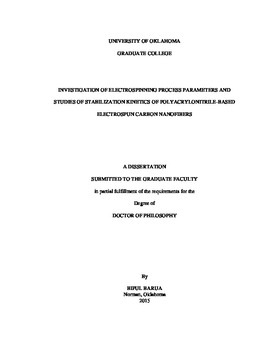| dc.description.abstract | Carbon nanofibers produced by electrospinning brings many advantages over carbon fibers made from conventional spinning methods as they are expected to possess less structural defects, superior mechanical performance, and higher surface area per unit volume. In this dissertation, an electrospinning setup is developed to fabricate aligned nanofibrous yarns from polyacrylonitrile (PAN) polymer using a rotating circular disk. The PAN-dimethylformamide (DMF) solution is fed using a vertical syringe, and nanofibers are collected from the grounded copper foil (width 1.27 cm) glued on the surface of a 25 cm diameter plastic disc. Various process parameters such as applied voltage, flow rate, and rotational speed are investigated. The alignment of the nanofibers is found to improve with increasing the rotation of the circular disc. The influence of electric field and flow rate on the fiber diameter and tensile properties of nanofibrous yarns is correlated with the Taylor cone half-angle at the tip of the needle and the fiber current. It is observed that a set of electric field and flow rate conditions favor producing thinnest, strongest, and toughest nanofibers. Other conditions may lead to instability of the Taylor cone, and as a result, discontinuous jet, larger diameter fiber, and lower mechanical properties are observed. A simple dynamic whipping model is adopted to correlate the fiber diameter with volumetric charge density and is found to be excellent validating the experimental results.
The influence of relative humidity (RH) and temperature on the morphology, structure, and mechanical properties of nanofibers is also investigated. It is observed that fibers show smooth surface and solid core to irregular surface and porous core depending on the RH and temperature. The resulting morphology is explained by the means of ternary phase diagram of water/DMF/PAN. At higher RH conditions, the water diffusion into the polymer-solution jet brings thermodynamic instability into the system leading to separation of two phases such as polymer-rich phase and polymer-lean phase, where the later contributes to the rough surface and porosity of the structure. Higher process temperature leads to porous morphology at higher RH owing to larger miscibility area in the ternary phase diagram. It is found that the tensile properties of nanofibrous yarns depend mostly on the amount of porosity, although both diameter and crystallinity play important role. Annealing is found to alleviate surface roughness, reduce internal porosity, and improve mechanical performance of porous nanofibers.
Various stabilization reactions of electrospun PAN nanofibers such as cyclization, oxidation, dehydrogenation, and crosslinking are studied by in-situ characterization techniques using differential scanning calorimetry (DSC) and thermal gravimetric analysis (TGA). In-situ shrinkage of the PAN nanofiber yarn is monitored to study the extent of the cyclization reaction, while the crosslinking reaction is evaluated from the dynamic mechanical analysis (DMA). It is found that complete cyclization occurs at 260°C for 189 minutes, while the crosslinking reaction becomes prominent after 132 minutes. Wide angle X-ray diffraction of the stabilized yarns and tensile property of the carbonized yarns reveal that the optimum stabilization time should be in between 132 and 189 minutes. It is also found that application of tension load during stabilization helps to improve the properties of carbonized yarn; however the tension load should be controlled to avoid any defects in the structure. | en_US |
